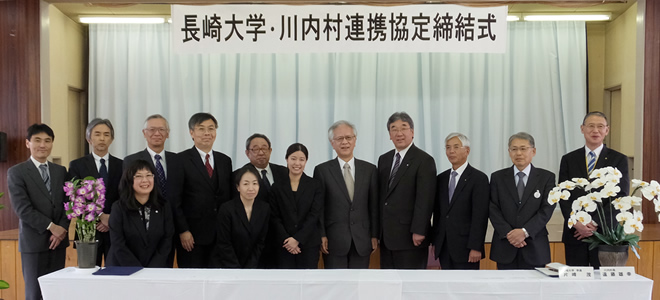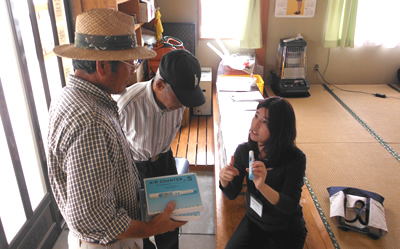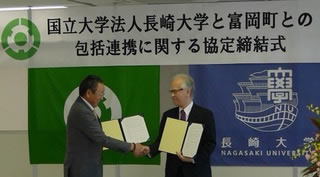
The Kawauchi Village Reconstruction Promotion Base

After the accident at Japan’s Fukushima Daiichi nuclear power plant, people in Kawauchi village were forced to do a temporary village-wide evacuation. In March 2012, following the containment of the accident, Kawauchi issued a “Return to the Village Statement,” which was the first of its kind in Fukushima Prefecture, and the village has been striving to reconstruct itself ahead of other municipalities.
Nagasaki University has been assisting Kawauchi’s reconstruction efforts since December 2011. Specifically, we have been providing scientific support for the residents’ return to the village and for reconstruction. For instance, before the return to the village we showed that returning was scientifically justified by estimating residents’ radiation exposure through measurement of radioactive substances in the soil. And in May 2012, a graduate student in the master’s program in the School of Health Sciences who is a public health nurse stayed for an extended period to conduct individual consulting on radiation exposure and health.
In the context of these activities, Nagasaki University and Kawauchi concluded an agreement on April 20, 2013, concerning comprehensive cooperation toward reconstruction of the village, and we established in the village a satellite facility of the university: the Nagasaki University - Kawauchi Village Reconstruction Promotion Base. At the base, public health nurse Makiko Orita, who is also a graduate student in the university’s doctor’s program, is stationed permanently. Closely cooperating with the village office, we are ensuring residents’ safety and peace of mind through measurement of radioactive substances in the soil and food, as well as providing health consultation services based on the obtained data. Moreover, with the support of faculty members of the School of Health Sciences, she is also ensuring that residents are healthy through efforts to rehabilitate the region, while paying attention to people’s decreased physical strength due to the prolonged evacuation after the earthquake. Furthermore, in cooperation with the Nuclear Safety Research Association, we introduced germanium semiconductor detectors in Kawauchi and thus established a system to measure radioactive substances more speedily and efficiently.
In utilizing such a base, the cooperation between Nagasaki University and Kawauchi is attracting attention as a model for reconstruction after the earthquake. With the Atomic Bomb Disease Institute playing a central role, we plan to continue our activities as we offer Fukushima support from Nagasaki University.

The Tomioka Town Reconstruction Promotion Base
With the Great East Japan Earthquake of March 11, 2011 and the resulting partial meltdowns at Tokyo Electric Power Co.'s Fukushima Daiichi Nuclear Power Plant, the town of Tomioka experienced three simultaneous disasters: an earthquake, a tsunami, and the release of radiation. The entire town was forced to evacuate.
Since these calamities, Tomioka has steadily undertaken rebuilding efforts, including decontamination, and in April 2017, six years after the nuclear accident, residents began to return. However, in an advance survey of residents’ intentions, only 13.9% of the 13,900 residents wished to return. For those in their teens and twenties, that figure dropped to 5.4%, so the proportion of young people among those who wished to return was particularly low. It is thought that anxiety about radiation exposure likely had an impact, in addition to a variety of social factors. The town is currently making progress to build a foundation that will enable full-scale reconstruction. As a result, ensuring safety and security through initiatives such as radiation dosage testing has become an important issue.
In April 2013, Nagasaki University entered into a comprehensive partnership agreement with Kawauchi, a village that is adjacent to Tomioka. The university established a satellite office in the village at which public health and other nurses were stationed. Based on measurements and evaluations of the external and internal radiation doses of residents, it carried out risk communication activities according to individual circumstances. These activities have been praised in both Japan and overseas as a “model case for recovery from a nuclear disaster in which residents, government, and experts are united.” In May 2014, the university established the Research and Support Center for the Future of Fukushima, which has been carrying out various initiatives for the reconstruction and regeneration of Fukushima, drawing on the full resources of the university.

Going forward, as Tomioka makes progress with the return of residents, Tomioka and Nagasaki University have signed an agreement aimed at even closer cooperation. It will contribute to the reconstruction and regeneration of Tomioka by using the specialized experience that Nagasaki University has already gained in Kawauchi; a Nagasaki University satellite office has also been set up inside the Health and Welfare Department of Tomioka. The agreement states that Nagasaki University and Tomioka will cooperate on the following: (1) evaluating external radiation doses by monitoring environmental radioactivity and measuring individual radiation doses; (2) evaluating internal radiation doses by measuring radioactivity in substances such as food; (3) based on the first two items, managing the health and ensuring the safety and security of residents by initiatives such as health counseling and lecture activities; (4) implementing any other steps necessary to achieve the goal of the agreement.
